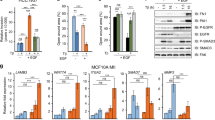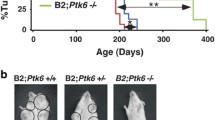Abstract
ErbB-3 (HER3) is a member of the epidermal growth factor receptor family. Increasing evidence suggests that elevated expression of ErbB-3 is important for malignancy. In this study, we found that elevated levels of ErbB-3 expression did not occur in the absence of AP-2γ in a panel of human mammary epithelial and fibroblasts cell lines. In contrast, there was no association between the expression of AP-2α or AP-2β and the level of ErbB-3, or between AP-2α and AP-2γ double positivity and ErbB-3 expression. In co-transfection experiments, exogenous expression of AP-2γ robustly activated ErbB-3 promoter activity. Moreover, expression of a dominant negative AP-2 protein, AP-2Delta; (deleted residues 31–117), not only repressed the ErbB-3 promoter activity but also suppressed endogenous ErbB-3 transcription in the ErbB-3 overexpressing cell line MRC-5VA. Overexpression of AP-2Δ resulted in a decreased proliferation rate and inhibition of colony formation. Taken together, these data strongly support a role for the AP-2 gene family, in particular, AP-2γ, in the control of ErbB-3 expression. Interference with the function of transcription factor AP-2 might provide a potential strategy for modulation of the malignant phenotype.
Similar content being viewed by others
REFERENCES
Prigent SA, Lemoine NR, Hughes CM, Plowman GD, Selden C, Gullick WJ: Expression of the c-c-erbB-3 protein in normal human adult and fetal tissues. Oncogene 7: 1273–1278, 1992
Stern DF, Kamps MP: EGF-stimulated tyrosine phosphorylation of p185neu: a potential model for receptor interactions. EMBO J 7(4): 995–1001, 1988
Plowman GD, Green JM, Culouscou JM, Carlton GW, Rothwell VM, Buckley S: Heregulin induces tyrosine phosphorylation of HER4/p180erbB4. Nature 366(6454): 473–475, 1993
Carraway KL, Sliwkowski MX, Akita R, Platko JV, Guy PM, Nuijens A, Diamonti AJ, Vandlen RL, Cantley LC, Cerione RA: The erbB3 gene product is a receptor forheregulin.J Biol Chem 269(19): 14303–14306, 1994
Slamon DJ, Clark GM, Wong SG, Levin WJ, Ullrich A, McGuire WL: Human breast cancer: correlation of relapse and survival with amplification of the HER-2/neu oncogene. Science 235(4785): 177–182, 1987
Kraus MH, Issing W, Miki T, Popescu NC, Aaronson SA: Isolation and characterization of ERBB3, a third member of the ERBB/epidermal growth factor receptor family: evidence for overexpression in a subset of human mammary tumors. Proc Natl Acad Sci USA 86: 9193–9197, 1989
Gilbertson RJ, Clifford SC, MacMeekin W, Meekin W, Wright C, Perry RH, Kelly P, Pearson AD, Lunec J: Expression of the ErbB-neuregulin signaling network during human cerebellar development: implications for the biology of medulloblastoma. Cancer Res 58(17): 3932–3941, 1998
Darcy KM, Zangani D, Wohlhueter AL, Huang RY, Vaughan MM, Russell JA, Ip MM: Changes in ErbB2 (her-2/neu), ErbB3, and ErbB4 during growth, differentiation, and apoptosis of normal rat mammary epithelial cells. J Histochem Cytochem 48(1): 63–80, 2000
Tuncer ZS, Vegh GL, Fulop V, Genest DR, Mok SC, Berkowitz RS: Expression of epidermal growth factor receptor-related family products in gestational trophoblastic diseases and normal placenta and its relationship with development of postmolar tumor. Gynecol Oncol 77(3): 389–393, 2000
Guy PM, Platko JV, Cantley LC, Cerione RA, Carraway KL: Insect cell-expressed p180erbB3 possesses an impaired tyrosine kinase activity. Proc Natl Acad Sci USA 91(17): 8132–8136, 1994
Borg A, Baldetorp B, Ferno M, Killander D, Olsson H, Ryden S, Sigurdsson H: ERBB2 amplification is associated with tamoxifen resistance in steroid-receptor positive breast cancer. Cancer Lett 81(2): 137–144, 1994
Sliwkowski MX, Schaefer G, Akita RW, Lofgren JA, Fitzpatrick VD, Nuijens A, Fendly BM, Cerione RA, Vandlen RL, Carraway KL: Coexpression of erbB2 and erbB3 proteins reconstitutes a high affinity receptor for heregulin. J Biol Chem 269(20): 14661–14665, 1994
Zhang J, Hagopian-Donaldson S, Serbedzija G, Elsemore J, Plehn-Dujowich D, McMahon AP, Flavell RA, Williams T: Neural tube, seletal and body wall defects in mice lacking transcription factor AP-2. Nature 381: 238–241, 1996
Funayama T, Nakanishi T, Takahashi K, Taniguchi S, Takigawa M, Matsumura T: Overexpression of c-c-erbB-3 in various stages of human squamous cell carcinomas. Oncology 55(2): 161–167, 1998
Lemoine NR, Barnes DM, Hollywood DP, Hughes CM, Smith P, Dublin E, Prigent SA, Gullick WJ, Hurst HC: Expression of the ERBB3 gene product in breast cancer. Br J Cancer 66(6): 1116–1121, 1992
Yi ES, Harclerode D, Gondo M, Stephenson M, Brown RW, Younes M, Cagle PT: High c-c-erbB-3 protein expression is associated with shorter survival in advanced non-small cell lung carcinomas. Mod Pathol 10(2): 142–148, 1997
Kapitanovic S, Radosevic S, Slade N, Kapitanovic M, Andelinovic S, Ferencic Z, Tavassoli M, Spaventi S, Pavelic K, Spaventi R: J Cancer Res Clin Oncol 126: 205–211, 2000
Schorle H, Meier P, Buchert M, Jaenisch R, Mitchell PJ: Transcription factor AP-2 essential for cranial closure and craniofacial development. Nature 381: 235–238, 1996
Nottoli T, Hagopian-Donaldson S, Zhang J, Perkins A, Williams T: AP-2-null cells disrupt morphogenesis of the eye, face, and limbs in chimeric mice. Proc Natl Acad Sci USA 95: 13714–13719, 1998
Williamson JA, Bosher JM, Skinner A, Sheer D, Williams Tand Hurst HC: Chromosomal mapping of the human and mouse homologues of two new members of the AP-2 family of transcription factors. Genomics 35: 262–264, 1996
Gaynor RB, Muchardt C, Xia Y, Klisak I, Mohandas T, Sparkes RS, Lusis AJ: Localization of the gene for the DNAbinding protein AP-2 to human chromosome 6p22.3-pter. Genomics 10: 1100–1102, 1991
Bosher JM, Totty NF, Hsuan JJ, Williams T, Hurst HC: The developmental regulated transcription factor AP-2 is involved in ERBB2 overexpression in human mammary carcinoma. Proc Natl Acad Sci USA 92: 744–747, 1995
Kannan P, Buettner R, Chiao PJ, Yim SO, Sarkiss M, Tainsky MA: N-ras oncogene causes AP-2 transcriptional selfinterference,which leads to transformation. Genes Dev 8: 1258–1269, 1994
Bosher JM, Williams T, Hurst HC: The developmental regulated transcription factor AP-2 is involved in ERBB2 overexpression in human mammary carcinoma. Proc Natl Acad Sci USA 92: 744–747, 1995.
Skinner A, Hurst HC Transcriptional regulation of the c-cerbB-3 gene in human breast carcinoma cell lines. Oncogene 8: 3393–3401, 1993
McPherson, LA„ Weigel RJ: AP2alpha and AP2gamma: a comparison of binding site specificity and trans-activation of the estrogen receptor promoter and single site promoter constructs. Nucl Acids Res 27: 4040–4049, 1999
Zhu CH, Huang Y, Oberley LW, Domann FE: A family of AP-2 proteins down-regulate manganese superoxide dismutase expression. J Biol Chem 276(17): 14407–14413, 2001
Garcia MA, Campillos M, Marina A, Valdivieso F, Vazquez J: Transcription factor AP-2 activity is modulated by protein kinase A-mediated phosphorylation. FEBS Lett 444(1): 27– 31, 1999
Nyormoi O, Wang Z, Doan D, Ruiz M, McConkey D, Bar-Eli M: Transcription factor AP-2alpha is preferentially cleaved by caspase 6 and degraded by proteosome during tumor necrosis factor alpha-induced apoptosis in breast cancer cells. Mol Cell Biol 21(15): 4856–4867, 2001
Williams T, Tjian R: Analysis of the DNA-binding and activation properties of the human transcription factor AP-2. Genes Dev 5: 670–682, 1991a
Moser M, Imhof A, Bauer R, Amselgruber W, Sinowartz F, Hofstadter F, Schule R, Buettner R: Cloning and characterization of a second AP-2 transcription factor: AP-2 beta. Development 121: 2779–2788, 1995
Alper O, De Santis ML, Stromberg K, Hacker NF, Cho-Chung YS, Salomon DS: Anti-sense suppression of epidermal growth factor receptor expression alters cellular proliferation, celladhesion and tumorigenicity in ovarian cancer cells. Int J Cancer 88(4): 566–574, 2000
Williams T, Tjian R: Characterization of a dimerization motif in AP-2 and its function in heterologous DNA-binding proteins. Science 251: 1067–1071, 1991b
Shen H, Wilkie T, Ashique AM, Narvey M, Zerucha T, Savino E, Williams T, Richman JM: Chicken transcription factor AP-2: cloning, expression and its role in outgrowth of facial prominences and limb buds. Dev Biol 188: 248–266, 1997
Monge I, Mitchell PJ: DAP-2, the Drosophila homolog of transcription factor AP-2. Mech Dev 76: 191–195, 1998
Wankhade S, Yu Y, Weinberg J, Tainsky MA, Kannan P: Characterization of the activation domains of AP-2 family transcription factors. J Biol Chem 275: 29701–29708, 2000
Moser M, Ruschoff J, Buettner R: Comparative analysis of AP-2 and AP-2 gene expression during murine embryogenesis. Dev Dyn 208: 115–124, 1997a
Moser M, Pscherer A, Roth C, Becker J, Mucher G, Zerres K, Dixkens C, Weis J, Guay-Woodford L, Buettner R, Fassler R: Enhanced apoptotic cell-death of renal epithelial cells in mice lacking transcription factor AP-2. Genes Dev 11: 1938–1948, 1997
Takahashi H, Oyama N, Itoh Y, Ishida-Yamamoto A, Kaneko F, Iizuka H: Transcriptional factor AP-2gamma increases human cystatin A gene transcription of keratinocytes.Biochem Biophys Res Commun 278(3): 719–723, 2000
Turner BC, Zhang J, Gumbs AA, Maher MG, Kaplan L, Carter D, Glazer PM, Hurst HC, Haffty BG, Williams T: Expression of AP-2 transcription factors in human breast cancer correlates with the regulation of multiple growth factor signalling pathways. Cancer Res 58: 5466–5472, 1998.
Huang Y, Domann FE: Transcription factor AP-2 mRNA and DNA binding activity are constitutively expressed in SV40-immortalized but not normal human lung fibroblasts. Arch Biochem Biophys 364: 241–246, 1999
Zhang L, Zhan S, Navid F, Li Q, Choi YH, Kim M, Seth P, Helman LJ:AP-2 may contribute to IGF-II overexpression in rhabdomyosarcoma. Oncogene 17(10): 1261–1270, 1998
Qin H, Sun Y, Benveniste EN: The transcription factors Sp1, Sp3, and AP-2 are required for constitutive matrix metalloproteinase-2 gene expression in astroglioma cells. J Biol Chem 274: 29130–29137, 1999
Author information
Authors and Affiliations
Rights and permissions
About this article
Cite this article
Zhu, CH., Domann, F.E. Dominant negative interference of transcription factor AP-2 causes inhibition of ErbB-3 expression and suppresses malignant cell growth. Breast Cancer Res Treat 71, 47–57 (2002). https://doi.org/10.1023/A:1013378113916
Issue Date:
DOI: https://doi.org/10.1023/A:1013378113916




